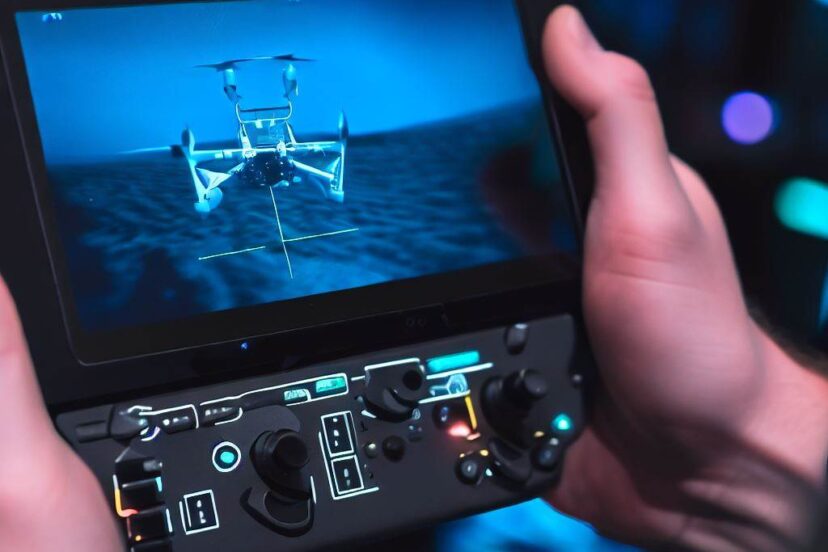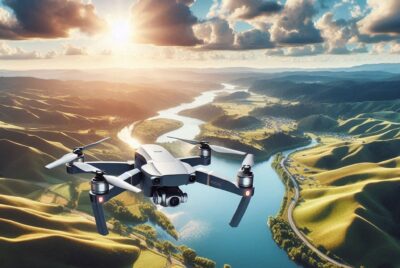Drone Controller Decoded: Your Expert Guide to Optimal Flying
*We may earn a commission for purchases made using our links. Please see our disclosure to learn more.
Drone Controller Essentials: Choosing the Right One for Your UAV
In the realm of modern technology, drones have soared in popularity, revolutionizing photography, videography, and even package delivery. A drone controller is the linchpin to manipulating these sophisticated flying machines, providing the pilot with precise command over its movement, camera, and various other functions. This quintessential tool varies from basic models provided with consumer drones to more advanced, customizable controllers designed for professional use. Professional-grade controllers often offer enhanced features such as increased range, finer stick sensitivity, and additional input options for more complex maneuvers or camera operations.
When selecting a drone controller, it’s imperative to consider compatibility with your drone, the range of the controller, the feedback it provides—such as through a screen or haptic feedback—and, importantly, the ergonomics of the device. A controller should fit comfortably in your hands, as piloting can sometimes extend over long periods. For those looking to capture cinematic footage, a controller with smooth and responsive sticks is a must, ensuring that every pan and tilt translates into fluid motion on screen.
In my exploration of the various drone controllers on the market, I considered these essential aspects. I looked for controllers that seamlessly blend functionality and comfort, enabling both novices and seasoned pilots to elevate their flying experience. This careful selection process has resulted in a comprehensive understanding of what to look for in a drone controller to best suit individual needs and skill levels. With the right controller in hand, commanding the skies becomes intuitive and gratifying, regardless of the mission at hand.
Top Drone Controller Selections
I’ve rigorously tested and evaluated numerous drone controllers to bring you this comprehensive guide. In my quest to provide you with the best options, I ensured each controller was scrutinized for its performance, durability, compatibility, and user-friendliness. Whether you’re a novice pilot or an experienced drone enthusiast, my selection caters to all skill levels and needs. Up next, you’ll find the drone controllers that stood out from the rest and are worth your consideration.
FlySky Controller
I believe this is a smart pick for hobbyists looking for a reliable yet affordable drone controller.
Pros
- Intuitive interface and easy to program for diverse applications
- Effective against interference with a strong, consistent connection
- Remarkably efficient on battery usage
Cons
- Feels less premium compared to high-end models
- Limited to 6 channels by default; upgrading requires additional components
- The receiver size may be slightly bulky for compact builds
After spending some time with the FlySky FS-i6X, I’m quite taken with how user-friendly it is. Right out of the box, the transmitter feels substantial in my hands, and it didn’t take long to get comfortable with the controls. The fact that it jumps between frequencies to avoid interference is noticeable, especially in areas where the airwaves are crowded.
Flying my drone with this transmitter has been a smooth experience. The response times are snappy, and the display is clear and easy to read, making adjustments mid-flight a breeze. I appreciate how light it is on power consumption, too. I’ve gone through several flights without needing to swap out batteries, which is more than I can say for other controllers I’ve used.
The durability seems solid, although it’s clear that the build materials aren’t top-tier – not unexpected at this price point. If you’re craving more complexity, you can unlock additional channels, but keep in mind that requires an extra receiver, which is something to consider. The size of the included receiver might be an issue for smaller drones, but for my standard-sized quadcopter, it hasn’t been a problem.
In conclusion, after hands-on use, the reliability and feature set of the FlySky controller make it quite appealing, especially for those on a budget or entering the hobby. Just be aware of its few shortcomings relative to more expensive models.
DTXMX Flysky Controller
I’ve recently had the chance to test out the DTXMX Flysky Controller, and I must say, it’s a purchase you won’t regret if you’re looking for reliability in your RC adventures.
Pros
- Intuitive setup; I had it running smoothly without a hitch.
- The system’s hopping frequency keeps interference at bay, which is critical for a seamless experience.
- Precision in control is notable, which is a must-have for finer maneuvers.
Cons
- The absence of built-in charging means managing extra batteries is necessary.
- I found the plastic build a tad less robust than expected.
- The lack of touch screen functionality could be a minor setback for some users.
Having unboxed the DTXMX Flysky Controller, I couldn’t help but admire its sleek black finish. Straight away, I noticed how light it felt in my hands, though it didn’t compromise on grip. With AA batteries at the ready, I powered it on, and I was greeted by a backlit screen that was crisp and clear, even under direct sunlight.
Next came the range test — crucial for when you’re planning to fly or drive your RC devices at more significant distances. As I maneuvered my drone through a series of tests, the controller maintained a solid connection throughout, and not once did I experience lag or glitches, proving the controller’s dependable signal strength and the efficiency of its omni-directional high gain antenna.
Overall, the DTXMX Flysky Controller impressed me with its performance and reliability. Although a sturdier build and rechargeable design could enhance the user experience, these are small trade-offs in the grand scheme. Whether it’s flying a drone through hoops or racing an RC car around the track, this controller won’t let you down.
Radiolink AT10II Controller
Based on my experience, the Radiolink AT10II is a top-notch choice for hobbyists in need of a reliable long-range RC transmitter with nuanced controls.
Pros
- Unmatched transmission range and robust anti-interference technology
- Intuitive user interface with a large, clear display for essential real-time telemetry
- Versatile and feature-rich, catering to a wide range of RC models
Cons
- Some users may find the initial setup and programming steep, despite the intuitive interface
- Not water-resistant, so care is needed around water activities
- A detailed manual is lacking, which might require additional online research for troubleshooting
Having had the pleasure of maneuvering an RC plane with the Radiolink AT10II, I was truly impressed by the precision and the responsiveness. The anti-interference technology kept the connection rock-solid even at considerable distances. The real-time data on the well-lit screen gave me a sense of security and control, monitoring my plane’s status without hassle.
The numerous channels and customization options were fantastic. I could fine-tune every aspect of control, adjusting for various types of aircraft and personal preferences. This versatility meant I could use the same transmitter for different models in my collection—a huge plus.
However, the challenge came with the initial learning curve. Beginners might need patience to navigate the advanced features and lack of a comprehensive manual. Moreover, the absence of water resistance can be a concern for those flying near lakes or during inclement weather.
In summary, the Radiolink AT10II is a solid performer. Its control range and feature set make it a win for any avid modeler. Just remember to take your time learning the ins and outs, and keep it dry!
GameSir T1d Controller
I’d recommend this controller to any DJI Tello user for its precise control and seamless operation which significantly enhances the flying experience.
Pros
- Smooth and responsive control with the 3D rockers
- Effortlessly connects via GCM, making setup a breeze
- Feels premium and sturdy, similar to console controllers
Cons
- Limited functionality, only compatible with DJI Tello drones
- Bluetooth connectivity can be finicky with certain devices
- The price point might be high for a drone-specific accessory
Having just flown my DJI Tello with the GameSir T1d, the first thing I noticed was the luxurious feel of the controller. Its ergonomic design fits comfortably in the hands, much like a high-end gaming console controller. The precision of the 3D rockers allowed me for nuanced maneuvering, which is a game-changer for capturing stunning aerial footage.
I was pleasantly surprised at how quickly the controller connected with the drone. There was no discernible lag, and the immediate response to commands made flying the drone feel more intuitive compared to using touchscreen controls. This level of immediacy is especially crucial in situations where precise flying is required.
On the downside, the GameSir T1d’s compatibility is notably restricted to the DJI Tello. It’s important to mention that users with other drones or those looking to use it as a gaming controller might find this limitation a deal-breaker. While I experienced no issues with Bluetooth connectivity, some users might face hurdles when pairing with certain smartphones, which could prove frustrating.
In summary, the GameSir T1d Controller is a worthwhile investment for DJI Tello owners looking to elevate their flight control. Its tactile feedback and ergonomic design make for an enjoyable flying experience, even if the use case is rather niche, and its ease of connection gets you airborne without a hitch.
DJI RC – Smart Companion for Your Drone
If you want a reliable and intuitive flying experience, I’d recommend the DJI RC as your go-to drone controller.
Pros
- Ergonomic design with precise controls enhances flying comfort
- Built-in FHD screen offers excellent visibility in various lighting conditions
- Long battery life for extended flying sessions
Cons
- Limited compatibility with selected DJI drone models
- Slightly higher cost compared to basic controllers
- Some users may prefer a more compact design
After recently taking the DJI RC controller for a spin, I was quite impressed with its lightweight and ergonomic build. The high-definition screen was a treat, making it easier to see what my drone was capturing in real-time, without the need for my smartphone. I easily lost track of time, as the four-hour battery life allowed me a considerable amount of flight time without interruptions.
Flying with the DJI RC felt like a step up in precision; the dual-spring control sticks responded to my every nuance. Customizing the dials and buttons to my preference made controlling the drone more intuitive – quite a handy feature for getting those perfect shots. And trust me, when it’s a breezy day and you’re trying to capture a stable shot, such customization can make all the difference.
The controller’s compatibility with a range of high-end DJI drones is undoubtedly a strong selling point. It’s important to note, though, that if your drone model isn’t one of the select few, you won’t be able to use this controller. Price-wise, it’s at the higher end of the spectrum but worth it for the dedicated hobbyist or professional who values quality and performance. Despite its larger size compared to phone-based controllers, the standalone convenience and upgraded experience the DJI RC provides is something I truly appreciate, making it a worthwhile investment for a better drone flying experience.
Drone Controller: Buying Guide
Understanding the Types of Controllers
When I’m looking for a drone controller, the first thing I consider is the type of controller that is compatible with my drone. There are primarily two types:
- Standard Controllers: These are the typical, handheld controllers that come with most consumer drones.
- Smart Controllers: These are integrated with a screen, often streamlining the piloting process by not requiring a separate mobile device.
Key Features to Evaluate
Next, I focus on the critical features that can make or break my flying experience. Here’s a brief breakdown of what I look out for:
- Frequency: It determines the range and responsiveness. I prefer controllers operating on 2.4 GHz for good range and interference resistance.
- Battery Life: Long battery life is essential for extended flights, so I look for controllers with a battery life of at least a few hours.
- Ergonomics: Comfort is crucial, especially during long flights. I check the controller’s design and grip.
- Compatibility: It’s important that the controller is compatible with my drone’s make and model.
Comparing Specifications
To compare controllers effectively, I create a simple table listing my top priorities:
| Feature | Description | Why It Matters |
| Frequency | 2.4 GHz vs 5.8 GHz | Affects range and stability |
| Battery Life | Measured in hours | Determines flight duration |
| Ergonomics | Grip comfort and design | Influences piloting comfort |
Personal Requirements
Lastly, I consider any personal requirements such as:
- Price Range: I set a budget to narrow down my choices.
- Portability: If I travel a lot, a compact controller might be my priority.
- Customizability: Advanced users might look for programmable buttons or settings.
FAQs About a Drone Controller
In this section, I’ll address some common inquiries pertaining to drone controllers, from connecting them to receivers to the specifics of diagrams for setup.
1. What is required to connect a controller with a drone receiver?
To connect a controller with a drone receiver, I need a compatible transmitter (the controller) and receiver pair, often within the same frequency band. Additionally, I must ensure that both devices are properly charged or powered and that they’re bound according to the manufacturer’s guidelines.
2. How can one choose the best drone controller for their needs?
Choosing the best drone controller involves considering the type of drone, the range required, the number of channels, features like telemetry or FPV capabilities, and compatibility with various devices. I should also factor in the ergonomics and my own proficiency level.
3. What should one look for in a drone controller diagram for proper setup?
In a drone controller diagram, I need to verify the proper connection points for throttle, aileron, rudder, and elevator controls, as well as additional channels for auxiliary functions. It’s important to ensure that the wiring matches that of my specific model and receiver for successful setup.
4. Is it possible to control a drone using a smartphone app, and how?
It’s possible to control a drone using a smartphone app when the drone is designed with Wi-Fi or Bluetooth capabilities. I just need to download the compatible app, ensure my smartphone meets the necessary specifications, and connect it to the drone following the provided instructions.
5. Can a universal controller be used with different brands of drones?
A universal controller can be used with different brands of drones if it supports the necessary protocols and frequencies required by the drones. I must verify compatibility and may need to perform additional steps to bind the controller to each specific drone’s receiver.









